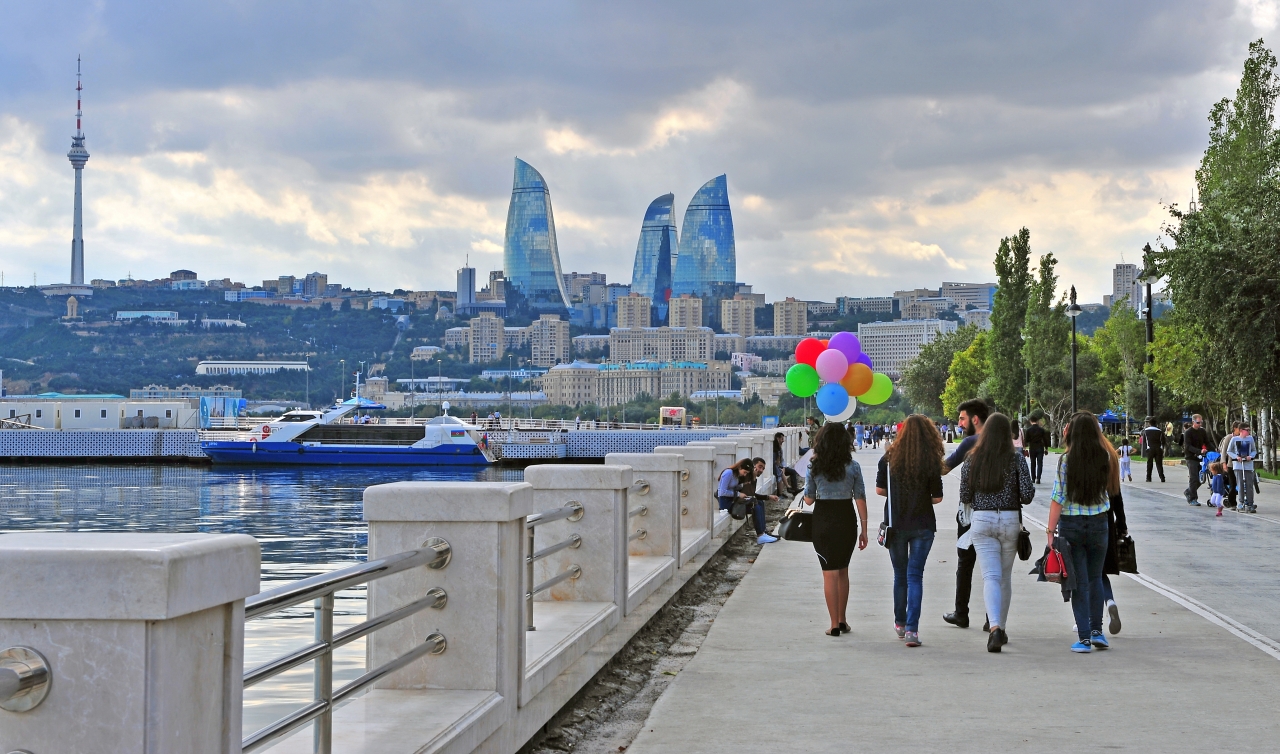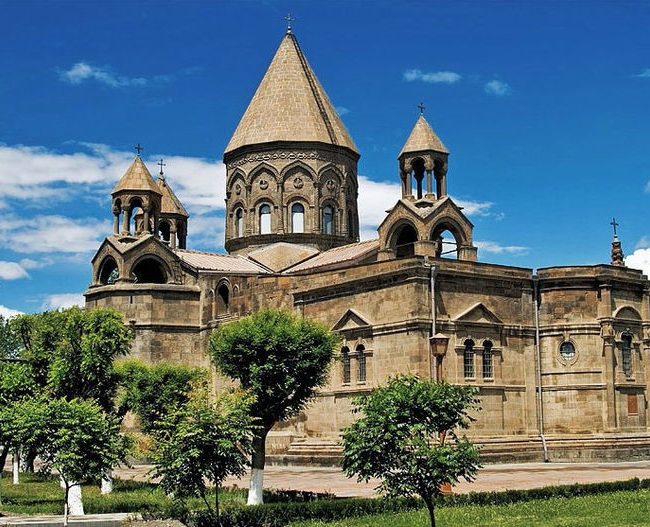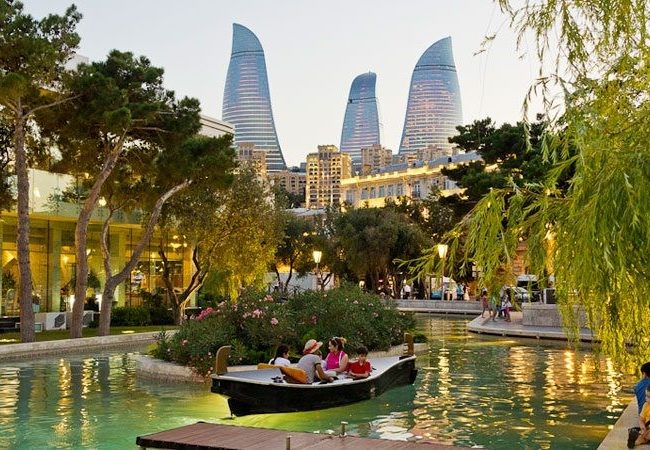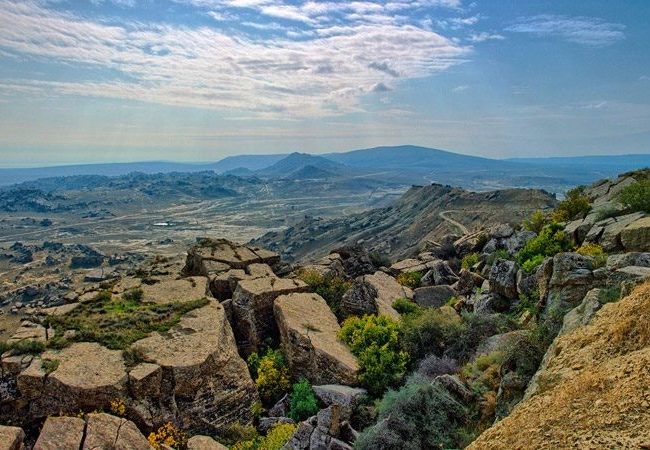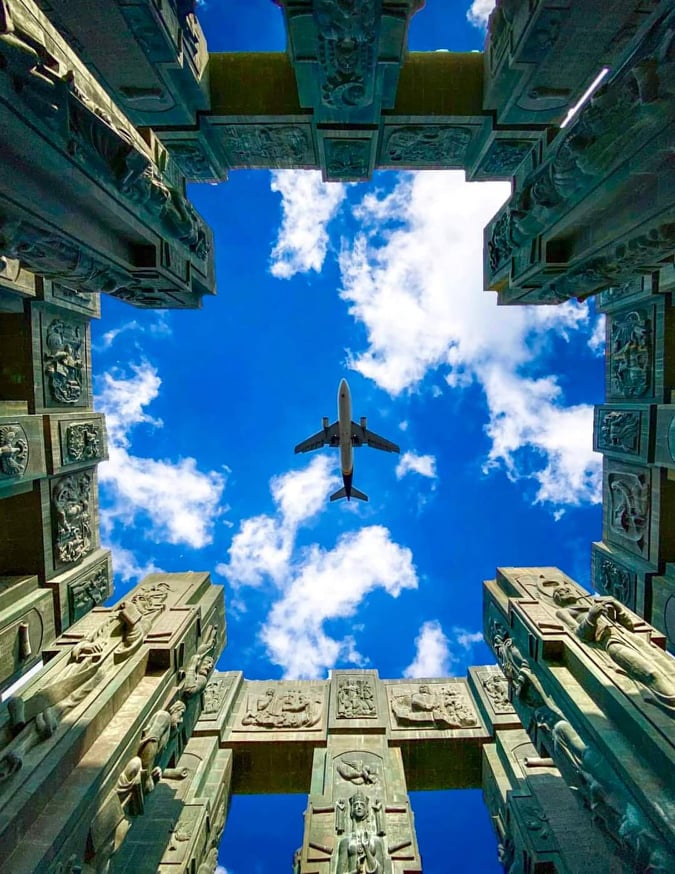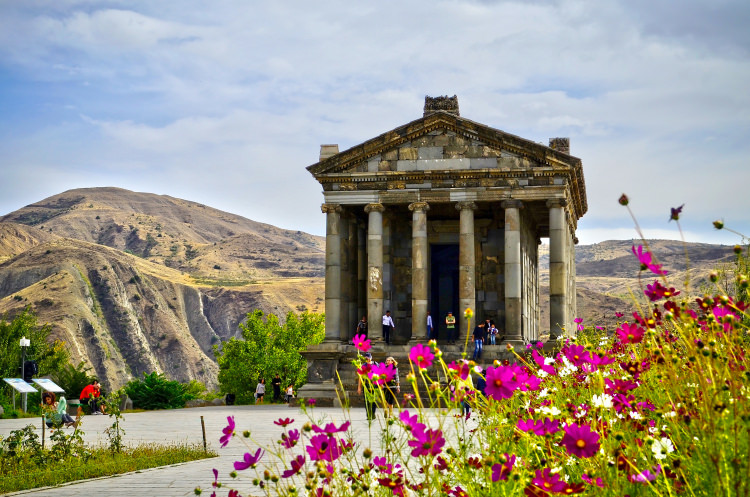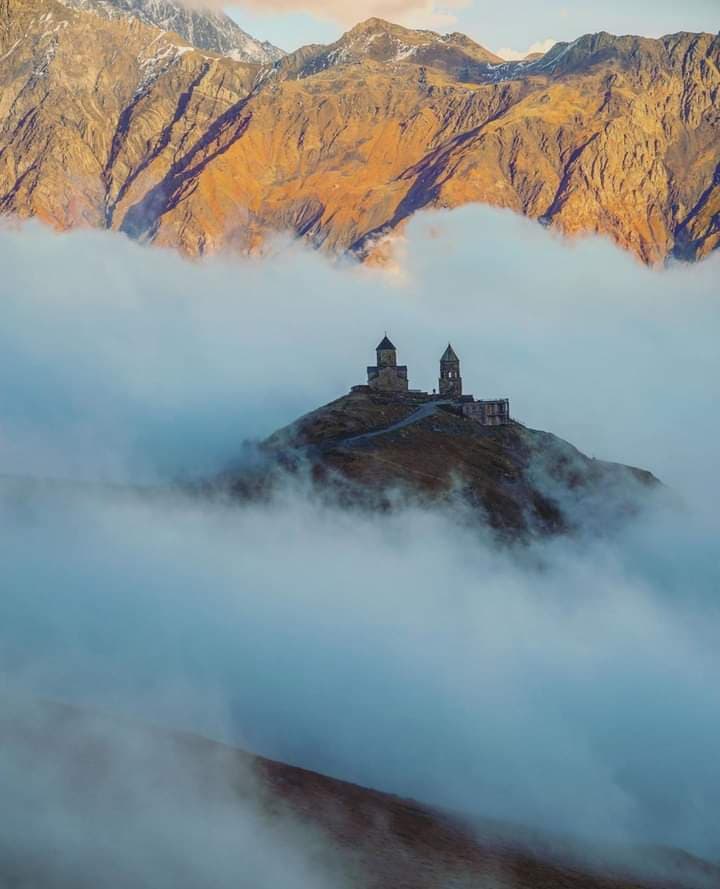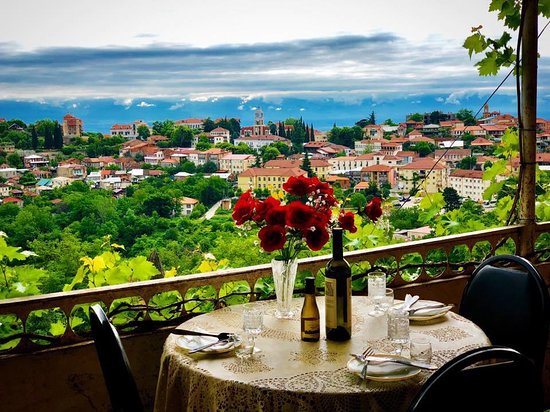Tour in Caucasus countries
Included in the price
• Transfer from/to the airport.
• Hotel accommodation – Double / Twin room.
• Daily breakfast at the hotel.
• Comfortable transport during the tour.
• Fuel according to the program.
• English-speaking guide during the trip.
• Entrance tickets according to the itinerary.
• 2 x bottles of water per person daily.
• 24/7 customer support.
Excluded from the price / Optional:
• Airplane tickets.
• Travel Insurance.
• Visa expenses at the border in case of need.
Tour Plan
Day 1: Baku.
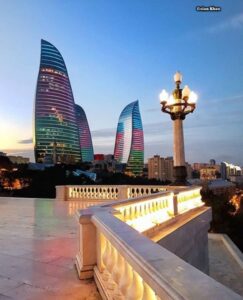 Arrive in Baku. Meeting at the airport. Check-in at the hotel. from 15:00. Leisure time.
Baku evening city tour. Walking in Old Baku. Visit Shirvanshahs' Palace – Palace of the Shirvanshahs is the most significant monument of the Shirvan-Absheron branch of Azerbaijan architecture, situated in The Inner City of Baku. The complex contains the main building of the palace,
Divanhane, the burial vaults, the shah’s mosque with a minaret, Seyid
Yahya Bakuvi’s mausoleum, a portal in the east – Murad’s gate, a
reservoir, and the remnants of the bathhouse.
Maiden Tower – The Maiden Tower also known locally as Giz Galasi,
located in the Old City, Baku, in Azerbaijan, was built in the 12th century
as part of the walled city. Together with the Shirvanshahs’ Palace. it forms
an ensemble of historic monuments inscribed in 2001 under the UNESCO
World Heritage List of Historical Monuments as cultural property.
Return to the hotel. Overnight in Baku.
Arrive in Baku. Meeting at the airport. Check-in at the hotel. from 15:00. Leisure time.
Baku evening city tour. Walking in Old Baku. Visit Shirvanshahs' Palace – Palace of the Shirvanshahs is the most significant monument of the Shirvan-Absheron branch of Azerbaijan architecture, situated in The Inner City of Baku. The complex contains the main building of the palace,
Divanhane, the burial vaults, the shah’s mosque with a minaret, Seyid
Yahya Bakuvi’s mausoleum, a portal in the east – Murad’s gate, a
reservoir, and the remnants of the bathhouse.
Maiden Tower – The Maiden Tower also known locally as Giz Galasi,
located in the Old City, Baku, in Azerbaijan, was built in the 12th century
as part of the walled city. Together with the Shirvanshahs’ Palace. it forms
an ensemble of historic monuments inscribed in 2001 under the UNESCO
World Heritage List of Historical Monuments as cultural property.
Return to the hotel. Overnight in Baku.
Day 2: Baku.
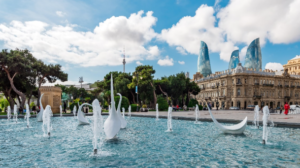 Breakfast at the hotel. Visit a new part of Baku.
Highland Park – Panoramic view of Baku Bay from the highest point of the
city. National Flag Square – One of the tallest flag of Azerbaijani fluttering in
the square of the National Flag in Baku. The height of the constructed pillar
is 162. Seaside Park (Baku Boulevard) – “The Boulevard” is a promenade parallel to Baku’s seafront. This area – famous for strolling and taking
in views of the Caspian – was recently named a national park.
Martyn’s Lane – upland park and the best panoramic view of the city of Baku.
Boulevard - a promenade established in 1909 which runs parallel to
Baku's seafront.
Breakfast at the hotel. Visit a new part of Baku.
Highland Park – Panoramic view of Baku Bay from the highest point of the
city. National Flag Square – One of the tallest flag of Azerbaijani fluttering in
the square of the National Flag in Baku. The height of the constructed pillar
is 162. Seaside Park (Baku Boulevard) – “The Boulevard” is a promenade parallel to Baku’s seafront. This area – famous for strolling and taking
in views of the Caspian – was recently named a national park.
Martyn’s Lane – upland park and the best panoramic view of the city of Baku.
Boulevard - a promenade established in 1909 which runs parallel to
Baku's seafront.
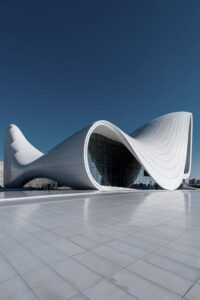 Its history goes back more than 100 years, to a time when
Baku oil barons built their mansions along the Caspian shore and when the
seafront was artificially built up inch by inch.
Heydar Aliyev Cultural Center (entrance fee excluded from the cost) –
a building complex in Baku, designed by Iraqi-British architect Zaha Hadid
and noted for its distinctive architecture and flowing, curved style that
eschews sharp angles.
Return to the hotel. Free evening.
Overnight in Baku.
Its history goes back more than 100 years, to a time when
Baku oil barons built their mansions along the Caspian shore and when the
seafront was artificially built up inch by inch.
Heydar Aliyev Cultural Center (entrance fee excluded from the cost) –
a building complex in Baku, designed by Iraqi-British architect Zaha Hadid
and noted for its distinctive architecture and flowing, curved style that
eschews sharp angles.
Return to the hotel. Free evening.
Overnight in Baku.
Day 3: Bibi-Heybat Mosque – Gobustan – Fire temple
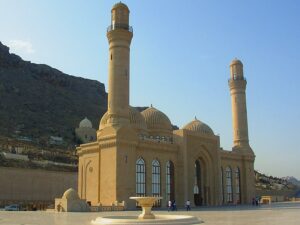 Breakfast at the hotel. Visit Bibi-Heybat Mosque. Visit Gobustan - Museum of Petroglyphs
(outdoor museum) – Gobustan another name for the Museum of Petroglyphs - is located
approximately 65 km from Baku. Prehistoric rock drawings – petroglyphs – are an art “archive” of the human evolution on Earth. The “articles” of such archives are the first
transmissions from the human “I” to the outer world. There are a few
such outdoor “archives” in Azerbaijan. One of them, the largest, is located
in Gobustan, at the Baku State Reserve of History, Ethnography, and Arts,
near Baku. It is a rocky massif on the bottom of the southeast part of the
Great Caucasus Range, near the Caspian Sea, and a modern highway built
on the ancient Shirvan road. In the mountains of Gobustan Beyukdash, Kichikdash, Djingirdag, and Shighgaya there were concentrated witnesses of the past of the Azerbaijanian nation of the epoch of Stone Age and ongoing periods – rocky paintings,
the camp of man, tombstones and etc. The most significant of them are
rocky pictures – petroglyphs, carved by primitive men on walls of
caves, rocks, and stony lumps. The aforesaid primitive monuments of art
Breakfast at the hotel. Visit Bibi-Heybat Mosque. Visit Gobustan - Museum of Petroglyphs
(outdoor museum) – Gobustan another name for the Museum of Petroglyphs - is located
approximately 65 km from Baku. Prehistoric rock drawings – petroglyphs – are an art “archive” of the human evolution on Earth. The “articles” of such archives are the first
transmissions from the human “I” to the outer world. There are a few
such outdoor “archives” in Azerbaijan. One of them, the largest, is located
in Gobustan, at the Baku State Reserve of History, Ethnography, and Arts,
near Baku. It is a rocky massif on the bottom of the southeast part of the
Great Caucasus Range, near the Caspian Sea, and a modern highway built
on the ancient Shirvan road. In the mountains of Gobustan Beyukdash, Kichikdash, Djingirdag, and Shighgaya there were concentrated witnesses of the past of the Azerbaijanian nation of the epoch of Stone Age and ongoing periods – rocky paintings,
the camp of man, tombstones and etc. The most significant of them are
rocky pictures – petroglyphs, carved by primitive men on walls of
caves, rocks, and stony lumps. The aforesaid primitive monuments of art
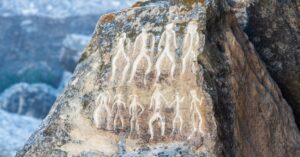 reflect the culture, economy, world outlook, customs, and traditions of ancient
Azerbaijanian peoples. The Baku Ateshgah, often called the Fire Temple of Baku" is a castle-like religious temple in Surakhani town - a suburb of Baku, Azerbaijan. Based on
Persian inscriptions, the temple was used as a Hindu, Sikh, and Zoroastrian
place of worship. Was built during the 17th and 18th centuries and abandoned in
the late 19th century. It is one of Azerbaijan’s most
remarkable sights. Return to the hotel. Overnight in Baku.
reflect the culture, economy, world outlook, customs, and traditions of ancient
Azerbaijanian peoples. The Baku Ateshgah, often called the Fire Temple of Baku" is a castle-like religious temple in Surakhani town - a suburb of Baku, Azerbaijan. Based on
Persian inscriptions, the temple was used as a Hindu, Sikh, and Zoroastrian
place of worship. Was built during the 17th and 18th centuries and abandoned in
the late 19th century. It is one of Azerbaijan’s most
remarkable sights. Return to the hotel. Overnight in Baku. Day 4: Baku – Sheki
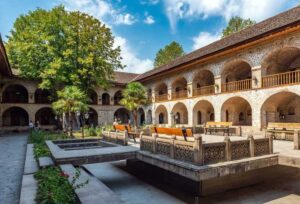 Breakfast at the hotel. Departure to Sheki. Sheki is a city in northwestern Azerbaijan,
located in the southern part of the Greater Caucasus mountain range. It is a beautiful village itself. The most famous sight is the Sheki Khans Palace, which
is built without using a single nail.
Check-in at the hotel.
City tour in Sheki.
Overnight in Sheki.
Breakfast at the hotel. Departure to Sheki. Sheki is a city in northwestern Azerbaijan,
located in the southern part of the Greater Caucasus mountain range. It is a beautiful village itself. The most famous sight is the Sheki Khans Palace, which
is built without using a single nail.
Check-in at the hotel.
City tour in Sheki.
Overnight in Sheki. Day 5: Baku – Lagodekhi – Signagi
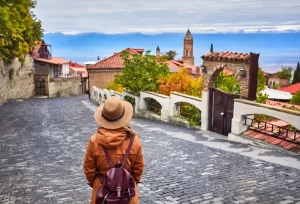 Breakfast at the hotel. Departure towards Georgia. Visit the Border near Lagodekhi.
Cross the border.
The Georgian guide will meet the guests at the border on the Georgian side.
Transfer to Signagi.
Visit Bodbe – St.George monastery complex and Nunnery of, one of Georgia’s
major pilgrimage sites with the grave of St. Nino (IVb) who brought Christianity to
Georgia. By the wish bathing in the holy waters of the miraculous source, that heals the sick. A trip to the city of love – Sighnaghi – a small town in the Alazani Valley.
Georgian town Sighnaghi is in the eastern part of Kakheti and is known as
the City of Love. Sighnaghi was also one of Georgia’s many stops along
the ancient Silk Road. Sighnaghi is just over an hour away from Tbilisi,
Breakfast at the hotel. Departure towards Georgia. Visit the Border near Lagodekhi.
Cross the border.
The Georgian guide will meet the guests at the border on the Georgian side.
Transfer to Signagi.
Visit Bodbe – St.George monastery complex and Nunnery of, one of Georgia’s
major pilgrimage sites with the grave of St. Nino (IVb) who brought Christianity to
Georgia. By the wish bathing in the holy waters of the miraculous source, that heals the sick. A trip to the city of love – Sighnaghi – a small town in the Alazani Valley.
Georgian town Sighnaghi is in the eastern part of Kakheti and is known as
the City of Love. Sighnaghi was also one of Georgia’s many stops along
the ancient Silk Road. Sighnaghi is just over an hour away from Tbilisi,
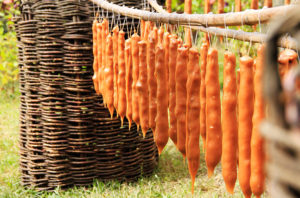 which makes it a good escape from the busy life of the city.
Optional offer: Master class of Georgian dishes. You’ll be able to cook
Khinkali, Khachapuri, or Georgian sweet Churchkhela – 15 EUR per
person. Wine tasting – 10 EUR per person.
Free evening. Overnight in Signagi or nearby.
which makes it a good escape from the busy life of the city.
Optional offer: Master class of Georgian dishes. You’ll be able to cook
Khinkali, Khachapuri, or Georgian sweet Churchkhela – 15 EUR per
person. Wine tasting – 10 EUR per person.
Free evening. Overnight in Signagi or nearby. Day 6: Tbilisi.
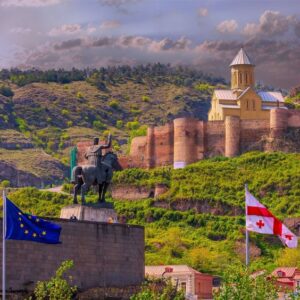 Breakfast at the hotel. Transfer to Tbilisi. On the way visit a local winery.
Have wine tasting, Arrive in Tbilisi.
Check-in at the hotel from 15:00 Leisure time 17:00 – 19:30 Tbilisi city tour.
Narikhala fortress –exists
since the mid-4th century. The fortress is built on a hill, therefore there is a
splendid view of the old city.
District sulfur baths and Legvtahevi – is in the center of the city. By the
legend, the foundation of Tbilisi became from hot sulfur springs. There were
also conducted archaeological excavations and were found ancient strata
of the city. Through the area Passes the rivulet of Legvtahevi. Her
beautiful canyon was hidden for decades, and only now has been
reconstructed - returned to its historic appearance.
Meydan - the central square of the old town, which was formerly a commercial
center of the city and nowadays is currently surrounded by cafe bars.
The Sharden area is full of narrow streets with cozy cafés, wine-tasting bars,
and souvenir shops. Bridge of peace. Gabriadze Theatre. Freedom Square.
Rustaveli Avenue. Return to the hotel. Overnight in Tbilisi.
Breakfast at the hotel. Transfer to Tbilisi. On the way visit a local winery.
Have wine tasting, Arrive in Tbilisi.
Check-in at the hotel from 15:00 Leisure time 17:00 – 19:30 Tbilisi city tour.
Narikhala fortress –exists
since the mid-4th century. The fortress is built on a hill, therefore there is a
splendid view of the old city.
District sulfur baths and Legvtahevi – is in the center of the city. By the
legend, the foundation of Tbilisi became from hot sulfur springs. There were
also conducted archaeological excavations and were found ancient strata
of the city. Through the area Passes the rivulet of Legvtahevi. Her
beautiful canyon was hidden for decades, and only now has been
reconstructed - returned to its historic appearance.
Meydan - the central square of the old town, which was formerly a commercial
center of the city and nowadays is currently surrounded by cafe bars.
The Sharden area is full of narrow streets with cozy cafés, wine-tasting bars,
and souvenir shops. Bridge of peace. Gabriadze Theatre. Freedom Square.
Rustaveli Avenue. Return to the hotel. Overnight in Tbilisi. Day 7: Ananuri – Gudauri – Kazbegi
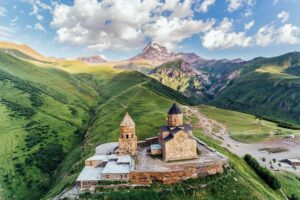 Breakfast at the hotel.
Departure towards Kazbegi – Mountain Region
Visit the Ananuri castle – complex on the Aragvi River
in Georgia, about 45 miles from Tbilisi. The castle is
from 13 th century which was the scene of numerous battles.
Visit Zhinvali reservoir.
Visit Gudauri - a mountain resort on the southern slopes of the Greater
Caucasus Mountain Range in Georgia, charming guests with great opportunities
for outdoor activities in the mountains, with amazing scenery and a friendly
atmosphere. Visit Gergeti trinity church - This architectural complex from the XIV century is in the village of Gergeti, at a height of 2200 m. The complex includes Holy Trinity Cathedral,
constructed in the XIV century, the bell tower, and clergy houses from the XV century.
Kazbegi is a beautiful place to visit, nature and the mountains make the view from the
church breathtaking. Return to Tbilisi. Overnight in Tbilisi.
Breakfast at the hotel.
Departure towards Kazbegi – Mountain Region
Visit the Ananuri castle – complex on the Aragvi River
in Georgia, about 45 miles from Tbilisi. The castle is
from 13 th century which was the scene of numerous battles.
Visit Zhinvali reservoir.
Visit Gudauri - a mountain resort on the southern slopes of the Greater
Caucasus Mountain Range in Georgia, charming guests with great opportunities
for outdoor activities in the mountains, with amazing scenery and a friendly
atmosphere. Visit Gergeti trinity church - This architectural complex from the XIV century is in the village of Gergeti, at a height of 2200 m. The complex includes Holy Trinity Cathedral,
constructed in the XIV century, the bell tower, and clergy houses from the XV century.
Kazbegi is a beautiful place to visit, nature and the mountains make the view from the
church breathtaking. Return to Tbilisi. Overnight in Tbilisi. Day 8: Dilijan – Sevan lake – Yerevan.
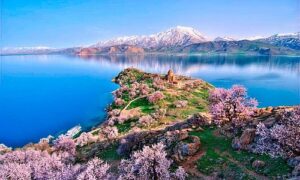 Breakfast at the hotel. Transfer to the Armenian border.
Cross the border. Armenian Guide will meet the guests at the border
on the Armenian side.
Departure towards Yerevan. On the way visit Sevani Lake - a large, high-altitude lake in eastern Armenia and the monastery Sevanavank - Sevanavank is a monastic complex located on a peninsula at the northwestern shore of Lake Sevan in the Gegharkunik Province of Armenia, not far from the town of Sevan. Visit Dilijan – a famous resort in Armenia
Dilijan entices people with its unforgettable beauty and mild climate.
The city stretches on the banks of the Aghstev River, surrounded by mountains
and forests. Dilijan has the fame of a health resort. The warm sun, fresh air, and natural spas have a great healing influence on people. Dilijan is also rich
in interesting architectural monuments.
Arrive in Yerevan. Check-in at the hotel. Free evening.
Overnight in Yerevan.
Breakfast at the hotel. Transfer to the Armenian border.
Cross the border. Armenian Guide will meet the guests at the border
on the Armenian side.
Departure towards Yerevan. On the way visit Sevani Lake - a large, high-altitude lake in eastern Armenia and the monastery Sevanavank - Sevanavank is a monastic complex located on a peninsula at the northwestern shore of Lake Sevan in the Gegharkunik Province of Armenia, not far from the town of Sevan. Visit Dilijan – a famous resort in Armenia
Dilijan entices people with its unforgettable beauty and mild climate.
The city stretches on the banks of the Aghstev River, surrounded by mountains
and forests. Dilijan has the fame of a health resort. The warm sun, fresh air, and natural spas have a great healing influence on people. Dilijan is also rich
in interesting architectural monuments.
Arrive in Yerevan. Check-in at the hotel. Free evening.
Overnight in Yerevan. Day 9: Yerevan
Breakfast. City tour in Yerevan. During the tour the
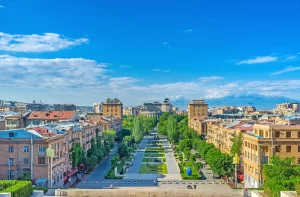 guests visit Armenian mother - Mother Armenia is a female personification
of Armenia. Her most public visual rendering is a monumental statue in Victory Park
overlooking the capital city of Yerevan, Armenia Yerevan Cascade - The Cascade is a giant stairway made of limestone in Yerevan, Armenia. It links the downtown Ketron area of Yerevan with the Monument neighborhood. Opera and ballet theatre - Armenian National Academic Theatre of Opera and Ballet named after Alexander Spendiaryan in Yerevan was officially opened on 20 January 1933, with Alexander Spendiaryans Almast's opera
performance. North Avenue - Northern Avenue is a pedestrian avenue in Yerevan,
Armenia. It is in the central Kentron district and links Abovyan Street with
Freedom Square on Tumanyan Street. It is 450 meters long and 27 meters
wide Republic Square - Republic Square is the central town square in Yerevan,
the capital of Armenia.
Visit Victory Park and the Statue Mother of Armenia
Free evening. Overnight in Yerevan.
guests visit Armenian mother - Mother Armenia is a female personification
of Armenia. Her most public visual rendering is a monumental statue in Victory Park
overlooking the capital city of Yerevan, Armenia Yerevan Cascade - The Cascade is a giant stairway made of limestone in Yerevan, Armenia. It links the downtown Ketron area of Yerevan with the Monument neighborhood. Opera and ballet theatre - Armenian National Academic Theatre of Opera and Ballet named after Alexander Spendiaryan in Yerevan was officially opened on 20 January 1933, with Alexander Spendiaryans Almast's opera
performance. North Avenue - Northern Avenue is a pedestrian avenue in Yerevan,
Armenia. It is in the central Kentron district and links Abovyan Street with
Freedom Square on Tumanyan Street. It is 450 meters long and 27 meters
wide Republic Square - Republic Square is the central town square in Yerevan,
the capital of Armenia.
Visit Victory Park and the Statue Mother of Armenia
Free evening. Overnight in Yerevan.
Day 10. Garni temple – Geghard Monastery
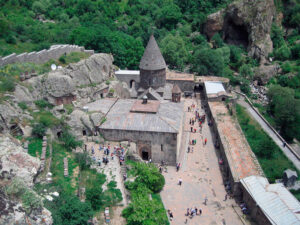 Breakfast at the hotel. Departure to Geghard - The monastery of Geghard and the Upper Azat Valley contains several churches and tombs, most of them cut into the living rock, which illustrates Armenian medieval architecture at its highest point. The complex of
medieval buildings is set into a landscape of great natural beauty, at the entrance to
the Azat Valley. High cliffs from the northern side surround the complex while the defensive wall encircles the rest. The monuments included in the property are dated from
the 4th to the 13th century. In the early period, the Monastery was called
Ayrivank (Monastery in the Cave) because of its rock-cut construction.
Have lunch.
Visit the Temple of Garni – this is the only standing Greco-Roman colonnaded
building in Armenia and the former Soviet Union. The ionic pagan temple located
in the village of Garni, Armenia, is the best-known structure and symbol
of pre-Christian Armenia.
Optional offer: Masterclass or baking
Armenian bread Lavash. Drive back to Yerevan. Overnight in Yerevan.
Breakfast at the hotel. Departure to Geghard - The monastery of Geghard and the Upper Azat Valley contains several churches and tombs, most of them cut into the living rock, which illustrates Armenian medieval architecture at its highest point. The complex of
medieval buildings is set into a landscape of great natural beauty, at the entrance to
the Azat Valley. High cliffs from the northern side surround the complex while the defensive wall encircles the rest. The monuments included in the property are dated from
the 4th to the 13th century. In the early period, the Monastery was called
Ayrivank (Monastery in the Cave) because of its rock-cut construction.
Have lunch.
Visit the Temple of Garni – this is the only standing Greco-Roman colonnaded
building in Armenia and the former Soviet Union. The ionic pagan temple located
in the village of Garni, Armenia, is the best-known structure and symbol
of pre-Christian Armenia.
Optional offer: Masterclass or baking
Armenian bread Lavash. Drive back to Yerevan. Overnight in Yerevan. Day 11: Yerevan – Echmiadzin – Zvartnots
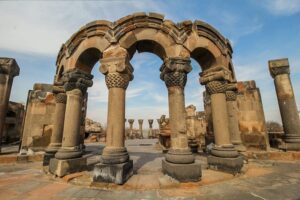 Departure to Vagharshapat. Visit Holy Ejmiatsin Cathedral was erected at that site in the 4th century (301-303), at the dawn of the Christian conversion of the country by King Trdat III
and Saint Gregory the Illuminator.
Visit Zvartnots. Zvartnots Cathedral is a medieval Armenian cathedral near Vagharshapat, Armenia. Built in the seventh century and now lying in ruins,
Zvartnots was noted for its circular exterior structure, unique in medieval Armenian architecture, and a set of interior piers that upheld a multi-floor structure crowned with a dome.
Return to Yerevan. Visit the local Market or shopping mall.
Return to the hotel.
Overnight in Yerevan.
Departure to Vagharshapat. Visit Holy Ejmiatsin Cathedral was erected at that site in the 4th century (301-303), at the dawn of the Christian conversion of the country by King Trdat III
and Saint Gregory the Illuminator.
Visit Zvartnots. Zvartnots Cathedral is a medieval Armenian cathedral near Vagharshapat, Armenia. Built in the seventh century and now lying in ruins,
Zvartnots was noted for its circular exterior structure, unique in medieval Armenian architecture, and a set of interior piers that upheld a multi-floor structure crowned with a dome.
Return to Yerevan. Visit the local Market or shopping mall.
Return to the hotel.
Overnight in Yerevan. Day 12: Yerevan – Departure
Breakfast at the hotel. Free time. Transfer to the airport. Departure.



